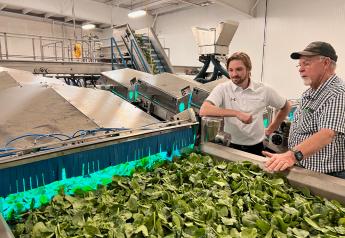USDA: Growing economies will fuel fresh produce economy through 2031

With global economic growth projected to average 3.1% annually from 2022 to 2031, the USDA is predicting a solid foundation for growth in U.S. fruit and vegetable imports in the next decade.
The USDA’s Agricultural Projections to 2031 report predicts agricultural exports will grow at an annual rate averaging just 0.8% per year from 2021 through 2031, while agricultural imports will increase by an average annual rate of 6% over that same period as domestic consumer spending is expected to remain strong.
U.S. imports of fresh fruits and vegetables will reach $38.5 billion in 2031, up 61% from $23.9 billion in 2020, the USDA said.
U.S. fresh fruit and vegetable exports will rise from $7 billion in 2020 to $7.3 billion in 2021, a gain of just 4%, according to the report.
The agency predicted that domestic production of fruits and vegetables will expand at a much slower pace, and that citrus production will trend lower.
The report predicts the COVID-19 pandemic is expected to fade into the rearview mirror.
"While only a handful of countries continue to remain in an economic recession, the vast majority are expected to report positive [gross domestic product] growth in 2021 as constraints on activity are relaxed," the USDA report said. "Improvements in the health situation, stronger demand for goods and services, and rapid hiring of workers continue to lead the way to faster economic growth."
The USDA predicted that, during 2022–2031, developing countries’ growth would be 4.3% annually, compared to an average of 2% for developed countries. “Both developing and developed economies will recover to the pre-pandemic projected GDP growth rates,” the USDA said.
Modest growth in U.S. output
The USDA said combined production of fruit, tree nuts, vegetable and pulses will grow slightly over the next decade, moving from 181 billion pounds in 2020 to 187 billion pounds by 2031.
By 2031, the report said, fruits would account for 24% of total output and tree nuts approximately 5%, while the volume of vegetable and pulse crops would total about 71%.
The USDA said vegetable and pulse crop production would grow only slightly between now and 2031, reflecting what the agency called “technical measurement issues” and rising import competition.
Recent years have seen rapid rise of import volume across many fresh and processed vegetables, including imports of organic foods produced in the Southern Hemisphere, and the USDA said its projection assumes imports continue to rise.
Meanwhile, the agency said the growth in greenhouse and vertical farms isn’t fully understood yet.
“Technical issues largely center on the rapid growth of the protected culture subsector (mostly greenhouses and urban vertical farms) that is slowly replacing field-grown production for several major fresh vegetables,” the report said. With some exceptions, greenhouses and vertical farms are not well represented in traditional USDA data collection programs that have recorded declining field-grown area and production for some crops, according to the report.
Helped by increasing production of higher-priced organic vegetables, the USDA said the value of fresh-market vegetable production will rise about 5% between 2019-2021 and 2029-2031.
The value of production for fresh market vegetables will account for about 61% of vegetable and pulse receipts by 2031. That would be up from an estimated 56% in 2020, the USDA said.
Within the lettuce subsector, the USDA said growth is projected in romaine production, while iceberg output will continue to decline. “Production of sweet potatoes continues to trend upward based primarily on rising exports,” the USDA said.
Citrus struggles
U.S. fruit and tree nut production is expected to reach 54.1 billion pounds in 2031, a decline from 54.7 billion pounds in 2020. Citrus output will decline from 13.8 billion pounds in 2021 to 12.5 billion pounds in 2031, the USDA said.
“Total citrus production levels are projected to decrease through the decade due to expected losses of orange and grapefruit bearing acreage in Florida,” the USDA said. “Projected growth in lemon and tangerine production are expected to somewhat temper orange and grapefruit production losses.”







